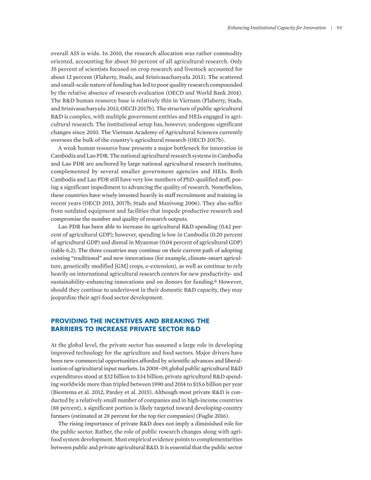Enhancing Institutional Capacity for Innovation | 93
overall AIS is wide. In 2010, the research allocation was rather commodity oriented, accounting for about 50 percent of all agricultural research. Only 35 percent of scientists focused on crop research and livestock accounted for about 12 percent (Flaherty, Stads, and Srinivasacharyulu 2013). The scattered and small-scale nature of funding has led to poor quality research compounded by the relative absence of research evaluation (OECD and World Bank 2014). The R&D human resource base is relatively thin in Vietnam (Flaherty, Stads, and Srinivasacharyulu 2013; OECD 2017b). The structure of public agricultural R&D is complex, with multiple government entities and HEIs engaged in agricultural research. The institutional setup has, however, undergone significant changes since 2010. The Vietnam Academy of Agricultural Sciences currently oversees the bulk of the country’s agricultural research (OECD 2017b). A weak human resource base presents a major bottleneck for innovation in Cambodia and Lao PDR. The national agricultural research systems in Cambodia and Lao PDR are anchored by large national agricultural research institutes, complemented by several smaller government agencies and HEIs. Both Cambodia and Lao PDR still have very low numbers of PhD-qualified staff, posing a significant impediment to advancing the quality of research. Nonetheless, these countries have wisely invested heavily in staff recruitment and training in recent years (OECD 2013, 2017b; Stads and Manivong 2006). They also suffer from outdated equipment and facilities that impede productive research and compromise the number and quality of research outputs. Lao PDR has been able to increase its agricultural R&D spending (0.42 percent of agricultural GDP); however, spending is low in Cambodia (0.20 percent of agricultural GDP) and dismal in Myanmar (0.04 percent of agricultural GDP) (table 6.2). The three countries may continue on their current path of adopting existing “traditional” and new innovations (for example, climate-smart agriculture, genetically modified [GM] crops, e-extension), as well as continue to rely heavily on international agricultural research centers for new productivity- and sustainability-enhancing innovations and on donors for funding.11 However, should they continue to underinvest in their domestic R&D capacity, they may jeopardize their agri-food sector development.
PROVIDING THE INCENTIVES AND BREAKING THE BARRIERS TO INCREASE PRIVATE SECTOR R&D At the global level, the private sector has assumed a large role in developing improved technology for the agriculture and food sectors. Major drivers have been new commercial opportunities afforded by scientific advances and liberalization of agricultural input markets. In 2008–09, global public agricultural R&D expenditures stood at $32 billion to $34 billion; private agricultural R&D spending worldwide more than tripled between 1990 and 2014 to $15.6 billion per year (Bientema et al. 2012; Pardey et al. 2015). Although most private R&D is conducted by a relatively small number of companies and in high-income countries (88 percent), a significant portion is likely targeted toward developing-country farmers (estimated at 28 percent for the top tier companies) (Fuglie 2016). The rising importance of private R&D does not imply a diminished role for the public sector. Rather, the role of public research changes along with agrifood system development. Most empirical evidence points to complementarities between public and private agricultural R&D. It is essential that the public sector

